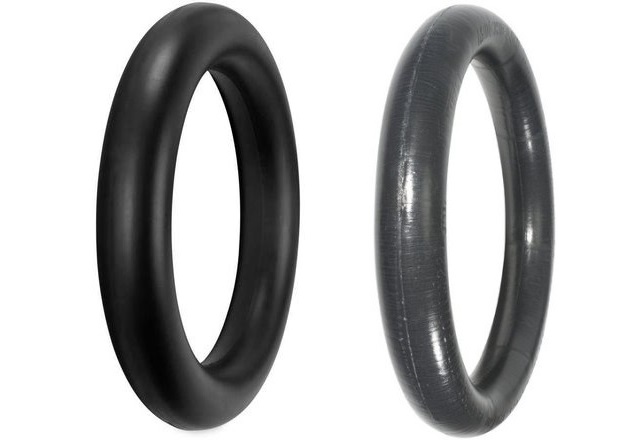
Lots of questions surround the growing popularity of the tire mousse and whether it offers a better flat-free alternative to the traditional tire tube.
Some riders swear by them. Others have never used them. Even more, some riders won't bother with a mousse system instead relying on the tried and true method of filling the tires with air. So after whipping a batch of fluffy chocolate (a name should exist for this dessert) and getting a bit tipsy on theobromine we took a closer look at the tire mousse and confirmed what you need to know.
The tire mousse began as the Bib-Mousse in 1984 by Michelin. Back then it was widely used for what most riders use it for today - off-road. But in recent years other tire companies joined the fray and for some reason after all this time the tire mousse has finally found better traction especially in Motocross. And though it truly offers an answer to flat tires, a tire mousse does not necessarily work well for everybody.
Nitro Mousse on the left; Bib Mousse on the right
Not Proprietary
Despite what you may have heard you can run the Michelin Bib-Mousse in a Dunlop tire or Goldentyre in Artrax so long as the sizes match. Granted the manufacturer recommends, and with good reason, you run their mousse with their tire you can get away with switching it around. However, only Nuetech offers a true universal tire mousse.
But if you love the mousse and either ride on tires that don't have an applicable mousse system or have found using an alternative manufacturer's mousse system for your tire does not work, just wait. More and more brands have tossed their tires into the ring and we expect additional tire mousse systems in the future. Until then, check out our current line of tire mousse products here.
Significant Weight Gains
A significant weight difference exists between a tire mousse and inner tube which explains why off-roaders use the mousse more than a racer. A rider shedding weight for Motocross might find the mousse system a bit heavy for their taste.
Don't Expect Easy Installation
If you find fixing a flat tire by replacing the inner tube daunting just wait until you slip around with a mousse like a mud wrestling match. These suckers do not install easy and test the most patient of mechanics. However, like a routine tire change once you have a few mousse installations under your belt, the process gets easier. You will likely need extra tools, extra hands and lots of theobromine.
Say Goodbye to Flats
The tire mousse indeed functions as advertised. You will not experience a flat tire when using a mousse which completely replaces the tube and air. Most installed mousse systems equal approximately 13 psi which means...
No Air Pressure Changes
You cannot change the tire pressure based on riding conditions. Therefore, you get one constant air pressure which brings an obvious benefit but also a big downside if riding conditions necessitate more or less tire pressure.
Expensive
The Michelin Bib-Mousse: $129.99. The Neutech Mousse: $124.99. OK, so our most expensive inner tube tops out at $44.99 with the Bridgestone Ultra Heavy Duty Tube. Or you can grab a very reliable Artrax Ultra Heavy Duty Tube for $19.99. As you can see, an inner tube costs far less than the mousse system. Indeed, the mousse probably lasts longer, especially since you can get a flat on a brand new tube, however...
Does Not Last Forever
The tire mousse does not last forever. Like all things mechanical, it wears out and eventually no longer works as advertised. Using the recommended gel lubrication helps extend the life of a mousse (and helps with installation) but with regular routine riding you can expect to replace the tire mousse every six months to a year or when it breaks down enough to feel like a flat tire.
A Different Feel
Experienced riders can tell right away whether a tube or mousse fills their tires. One complaint lodged against the mousse system comes from the "dead" feel. You don't get the rebound given off from a tube however this might just require getting used to riding on a dense foam insert rather than an air filled rubber inner tube. Keep in mind, though, off-road riders report a much softer feel with the mousse when hitting large boulders and logs.
Goldentyre G-Mousse
The tire mousse remains quite popular with the off-road crowd considering the higher risk of flats but Motocross continues to make inroads with mousse use and certainly Jason Anderson would have appreciated using the mousse system when his front tire went flat in the penultimate round of the 2018 Supercross season when he was leading in points.
If you attract flat tires like some people attract mosquitoes then the mousse system might work quite well on your bike. But if a heavy duty tube has kept you flat free for the last five years and fellow riders come to you for tires changes, then switching to a tire mousse makes little sense.
Still on the fence? Read "Pros and Cons: Heavy Duty Tubes vs. TUbliss vs. Mousse" for a direct comparison of the three available components that keep your tires rolling.










